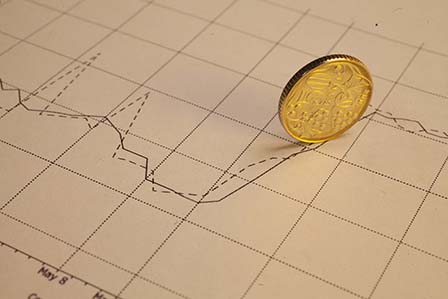In December 2015, the growth rate of consumer prices index (CPI) for the last 12 months constituted 13.6 percent, by 0.1 percentage points more compared to the previous month, exceeding further the upper limit of the range of ± 1.5 percentage points from 5.0 percent target.
The monetary policy continues to be affected by the complexity of risk balance, with a prevalence of inflationary risks. The external risks to inflation remain significant, given the weak economic activity of the euro area countries and deepening recession faced by the Russian Federation - the main external trade partners of the Republic of Moldova. The external risks are propagated through the channel of remittances in favour of population and external trade, leading to lower foreign currency income of population and domestic exporters in the short-term with implications for the future development of inflation.
Risks to inflation associated mainly with the depreciation of the national currency in the previous year, which will subsequently determine the CPI in the future periods, through the prices of imported goods and tariffs of regulated services, higher excise duty on some categories of goods and later through the second-round effects to remain temporarily on the upper limit of range of ± 1.5 percentage point from the 5.0 percent target. Inflationary pressures are expected to be persistent in the following quarters, including due to unfavourable agri-meteorological conditions in the previous year.
In December, the annual inflation rate was 13.6 percent, increasing by 0.1 percentage points compared to the previous month, by 8.9 percentage points higher than in December 2014. Similarly to previous periods, the dynamics of annual core inflation and food prices exerted the greatest impact on the annual inflation rate. The contribution of food prices remained at the previous month level of 5.0 percentage points, while that of core inflation increased by 5.0 percentage points. Significant positive contributions of core inflation and food prices are mainly the result of national currency depreciation and the drought recorded in 2015. At the same time, contributions from regulated prices and fuel prices remained at the level of November, constituting 3.3 and 0.2 percentage point, respectively.
Monthly inflation rate constituted 0.8 percent mainly due to the increase of food prices by 1.2 percent and non-food prices by 0.8 percent. Prices of services have increased by 0.1 percent.
The annual rate of core inflation was 14.6 percent in December 2015, increasing by 0.5 percentage points compared to the previous month.
In December 2015, the annual rate of core inflation was 1.1 percent. The most significant positive contributions were generated by the change in prices of "means of transport, auto parts" (3.0 percent), "cigarettes" (1.7 percent), "footwear" (1.2 percent), and "clothing" (1.1 percent).
Food prices increased by 1.2 percent in the reporting month compared to November 2015, due to higher prices of "fresh vegetables" by 8.0 percent, "potatoes" by 1.8 percent, "fats" by 1.1 percent, "fish and canned fish" by 1.1 percent, "milk and dairy products" by 0.9 percent and "non-alcoholic beverages" by 0.8 percent.
Excluding seasonal factors, food prices increased by 0.5 percent compared to the previous month. Thus, positive contributions to the formation of the monthly rate of food prices were recorded by sub-groups "fresh vegetables", "milling and bakery products" and "fats". It should be mentioned that the increase in prices of the aforementioned products was influenced mainly by the drought recorded in the summer 2015, which caused extensive damage to the agricultural production in the respective period.
The annual growth rate of food prices was 14.3 percent, decreasing by 0.2 percentage points compared to November 2015, but increasing by 9.2 percentage points compared to December 2014.
In December 2015, fuel prices decreased by 0.3 percent compared to the previous month. This development was mainly influenced by lower prices of "fuels" by 1.3 percent. However, the prices of "earth coal" and "firewood" went up slightly by 0.3 and 0.2 percent, respectively. The prices of "bottled gas" and "liquid fuel" remained at the previous month level.
The annual growth rate of fuel prices was 3.2 percent in December 2015, by 0.1 percentage points higher compared to November 2015 and by 3.2 percentage points lower than in December 2014.
In mid-November, the regulated tariffs for natural gas supply and distribution services, tariffs for natural gas transport services and the tariffs approved by the decision of the Council of Administration of ANRE of 18 July 2015. The consequences of these actions were manifested by the reduction of prices for gas from the grid services in the CPI over two months (November and December).
Thus, in December, prices for gas from the grid supply services decreased by 3.2 percent. However, positive developments were recorded by the transport services component, especially urban transport (1.0 percent), air transport (2.1 percent), rail services (2.3 percent), and tariffs of drinking water and transportation of waste (Edineţ) (6.3 and 3.7 percent, respectively). Medicines prices continued to show a positive trend, but more modest compared to the previous periods, increasing by 0.2 percent versus November 2015. In this context, regulated prices experienced an almost zero dynamics versus November 2015.
The annual growth rate of prices of regulated goods and services was 13.5 percent, by 0.2 percentage points lower compared to the previous month and by 12.0 percentage points more compared to the value recorded in December 2014.
NBM will further monitor and anticipate the domestic and international economic environment developments, including household consumption dynamics, remittances, monetary and foreign exchange indicators and changing foreign trade conditions, so that by the flexibility of operational framework specific for the inflation targeting strategy to ensure price stability in the medium term.





















